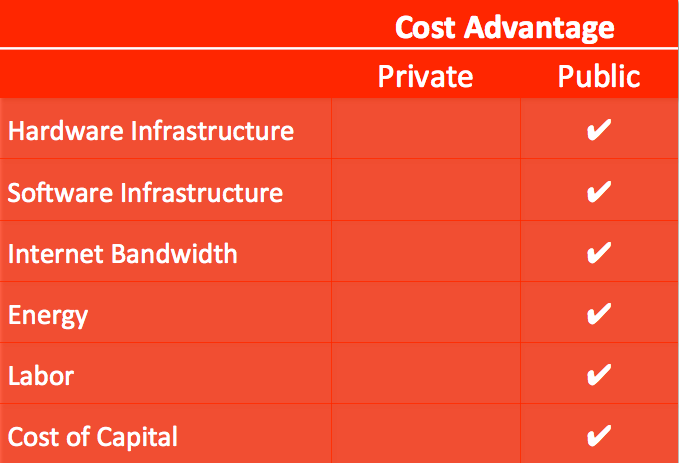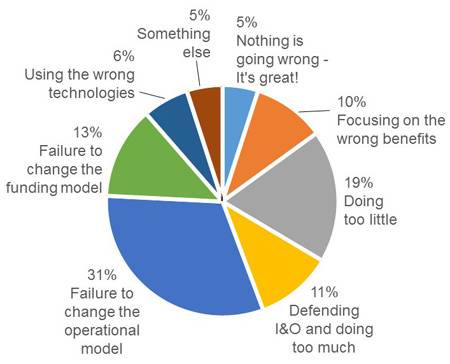You can’t really blame your IT staff for inflicting a private cloud—actually just a corporate data center with a fancy new name—on you. In some ways, their jobs depend upon it. Self-preservation is a powerful incentive.
Of course, your CIO’s job is only truly threatened by the public cloud if she chooses to fight it, or mindlessly continues to believe she can build a better cloud than Amazon, Google, and Microsoft. For 99.999% of enterprises, building your own cloud or data center may be a comforting way to stick with old habits, but it’s generally going to be the wrong decision.
While there are certainly workloads that will perform better or need to be secured within the four walls of your firewall, the reality is that most infrastructure belongs in the cloud.
No, You Can’t
It’s a convenient fiction that public cloud is unreliable compared to private IT. But let’s be clear: it’s fiction, not fact.
Here’s the reality on public cloud up-time: last year Amazon Web Services managed 99.9974% uptime despite hefty growth and unparalleled pressure on its infrastructure. Google was even better at 99.999% uptime. (Microsoft Azure performed a bit worse, though still quite well, according to the Cloud Harmony data.)
This is better than most enterprises can boast and, as AWS is demonstrating, the public cloud providers keep getting better at uptime.
In other words, public cloud costs considerably less than data center resources (even if dressed up as “private cloud”)—a huge advantage, by Actuate executive Bernard Golden’s estimation:

But it also performs better. And, most important of all, public cloud computing offers dramatic improvements in convenience and flexibility.
Sure, there are companies like Uber and Facebook that may be able to run infrastructure more efficiently than AWS or Microsoft, but these are the exceptions, not the rule, as Golden goes on to note.
Cloudy Forecast For IT Jobs?
None of which need threaten IT professionals. After all, “cloud” doesn’t translate into “unemployment.” Instead, it translates into “leverage.”
Take AccuWeather, for example, which discovered that the public cloud gave it the opportunity to highly leverage the relatively small IT staff it had. As Christopher Patti, vice president of Technology at AccuWeather, told CIO.com:
We don’t have a gigantic staff. In the past it took a serious amount of time to provision equipment. Now my development staff can go to the Web and click a few buttons and have a full environment deployed worldwide. The whole concept of the company has changed. We don’t have this locked-in, capital expenditure artificial boundary around us anymore.
Oh, and by the way, this steady state of headcount was able to manage a dramatic increase in scale: 2 million server calls hitting its services to more than 4 billion requests a day within five years.
Persistently Retro
None of which is stopping CIOs from believing that the private cloud remains relevant to their futures, despite investing much more heavily in public cloud last year, as RightScale’s State of the Cloud survey shows.
For example, adoption of OpenStack private clouds barely limped to a 1% gain (from 12% to 13%). And while 33% of respondents claimed to be using VMware’s vSphere for their private cloud deployments in 2015, that’s a mere 2% gain from 2014 (31%).
RightScale isn’t ready to write off the private cloud, though its defense is actually an indictment:
The slowing of adoption in private cloud is likely caused by the much talked about complexities of standing up and deploying a private cloud environment. However, interest levels remain strong, so this could lead to a reacceleration of growth over the next year.

It is precisely those complexities that call into question the very purpose of private cloud computing. Gartner finds that 95% of private clouds are failing. When asked how IT executives’ private cloud initiatives were going, a mere 5% could claim that “nothing is going wrong.”
That’s pretty terrible.
It’s not surprising, though. Way back in 2008 Redmonk analyst James Governor pointed out 15 ways to tell fake cloud from real cloud (Here’s just one: “If you own all the hardware… it’s not a cloud”). Those remain true today.
Public Cloud And Iteration
This is merely a sign of the private-cloud times, because private cloud, like private data centers before it, requires an enterprise to buy into fixed hardware resources when its actual needs are highly elastic.
As AWS data science chief Matt Wood told me, this is particularly thorny for Big Data projects, but his principles apply across the enterprise IT landscape:
Those that go out and buy expensive infrastructure find that the problem scope and domain shift really quickly. By the time they get around to answering the original question, the business has moved on. You need an environment that is flexible and allows you to quickly respond to changing big data requirements. Your resource mix is continually evolving—if you buy infrastructure it’s almost immediately irrelevant to your business because it’s frozen in time. It’s solving a problem you may not have or care about any more.
Which is just one more reason that more and more workloads will migrate to the public cloud.
Enterprises can’t afford to lock themselves into yesterday’s hardware to solve tomorrow’s problems. They need to remain agile, and public cloud infrastructure enables such agility, even as it drives cost and reliability advantages.
So what are you waiting for?
Photo by George Thomas









